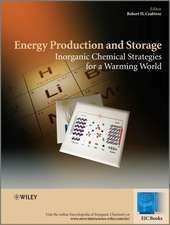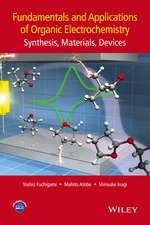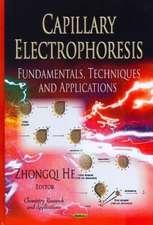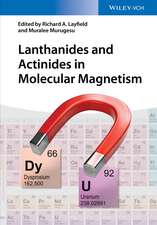Charge Transfer Reactions in Electrochemical and Chemical Processes
Autor L.I. Krishtaliken Limba Engleză Paperback – 12 iun 2012
Preț: 647.08 lei
Preț vechi: 761.27 lei
-15% Nou
Puncte Express: 971
Preț estimativ în valută:
123.82€ • 132.41$ • 103.24£
123.82€ • 132.41$ • 103.24£
Carte tipărită la comandă
Livrare economică 18 aprilie-02 mai
Preluare comenzi: 021 569.72.76
Specificații
ISBN-13: 9781468487206
ISBN-10: 1468487205
Pagini: 348
Ilustrații: XVIII, 344 p. 29 illus.
Dimensiuni: 178 x 254 x 18 mm
Greutate: 0.6 kg
Ediția:Softcover reprint of the original 1st ed. 1986
Editura: Springer Us
Colecția Springer
Locul publicării:New York, NY, United States
ISBN-10: 1468487205
Pagini: 348
Ilustrații: XVIII, 344 p. 29 illus.
Dimensiuni: 178 x 254 x 18 mm
Greutate: 0.6 kg
Ediția:Softcover reprint of the original 1st ed. 1986
Editura: Springer Us
Colecția Springer
Locul publicării:New York, NY, United States
Public țintă
ResearchCuprins
1. The Phenomenological Theory of an Elementary Act.- 1.1. The Brønsted Relation and the Activation Energy of Electrode Reactions.- 1.2. The Temperature Dependence of the Rate of an Electrode Reaction.- 1.3. The Chemical Potential of an Electron, Absolute Potential Drop, and Solvation Energy in Electrochemical Kinetics.- 1.4. The Brønsted Relation and the Activity Coefficient of an Activated Complex.- 1.5. Barrierless and Activationless Processes.- 1.6. Kinetic Equations for Discharge.- 2. Barrierless Discharge in Cathodic Hydrogen Evolution.- 2.1. The Discharge of Hydronium Ions at a Mercury Cathode.- 2.2.* Hydrogen Evolution in the Presence of Tetraalkylammonium Ions. Discharge of Undissociated Acid Molecules.- 2.3. The Activity Coefficient of an Activated Complex.- 2.4. The Temperature Dependence of the Rate of a Barrierless Discharge.- 2.5.* Evolution of Hydrogen at a Silver Cathode.- 2.6.* Evolution of Hydrogen at Other Cathodes.- 2.7. Some Theoretical Problems.- 3. The Quantum-Mechanical Theory of an Elementary Act.- 3.1. Introduction.- 3.2. An Ion in a Polar Solvent.- 3.3. The Elementary Act of Electron Transfer.- 3.4. Adiabatic and Nonadiabatic Transitions.- 3.5. Quantum and Classical Degrees of Freedom. Proton Transfer.- 4. Experimental Verification of the Theories of an Elementary Act of Proton Donor Discharge.- 4.1. Statement of the Problem.- 4.2. Barrierless Discharge. Preexponential Factor for Barrierless and Ordinary Processes.- 4.3. Kinetic Isotope Effect for Metals with High Hydrogen Overpotentials.- 4.4. Effect of the Nature of the Electrode Metal on the Preexponential Factor and the Kinetic Isotope Effect.- 4.5. Effect of the Potential and the Nature of Proton Donors on the Preexponential Factor and the Kinetic Isotope Effect.- 4.6. Effect of theNature of the Solvent on the Elementary Act of the Discharge of Proton Donors.- 4.7. Conclusion.- 5. Discharge of Heavy Ions. Quasibarrierless and Quasiactivationless Processes.- 5.1. The Elementary Act of a Process Accompanied by the Motion of Heavy Particles.- 5.2. The Theory of Quasibarrierless and Quasiactivationless Processes.- 5.3. Anodic Evolution of Chlorine at a Graphite Electrode.- 5.4.* The Chlorine Evolution Reaction at Ruthenium Dioxide-Titanium Dioxide Anodes.- 5.5.* The Kinetics of Oxidation of an Azide Ion at a Platinum Anode.- 5.6. On the Possibility of Other Quasibarrierless and Quasiactivationless Electrode Reactions.- 6. Mechanism of an Elementary Act and the Kinetics of the Cathodic Evolution of Hydrogen.- 6.1. Kinetic Isotope Effect and ?1-potential. Localization of a Discharging Ion.- 6.2.* Kinetic Isotope Effect. Discrimination of the ?1-effect and the Action of Other Factors.- 6.3.* Hydrogen Evolution at Certain Liquid Alloys.- 6.4. Mechanism of Amalgam Decomposition.- 6.5. Hydrogen Evolution at Iron, Chromium and Manganese during Their Chemical Self-dissolution and Cathodic Polarization.- 6.6. The Ratio of Ortho- and Para-forms of Hydrogen in an Electrolytic Gas.- 6.7. Cathodic Hydrogen Evolution in Nonaqueous Solvents.- 6.8. Electrode Reactions Involving Atomic Hydrogen Generated Through Interaction with Photoelectrons.- 7. Kinetics of Homogeneous and Enzymatic Reactions Involving Charge Transfer.- 7.1. Kinetic Isotope Effect in Homogeneous Proton Transfer Reactions.- 7.2. Medium Reorganization Energy in Proton Transfer Reactions. Comparison of Homogeneous and Electrode Reactions.- 7.3. Simultaneous Transfer of Two Charges. Coupling of Endoergic and Exoergic Reactions.- 7.4. Proton Transfer in Enzymatic Hydrolysis Reactions. Kinetic IsotopeEffect.- 7.5. On the Theory of Enzymatic Charge Transfer Reactions.- References.











